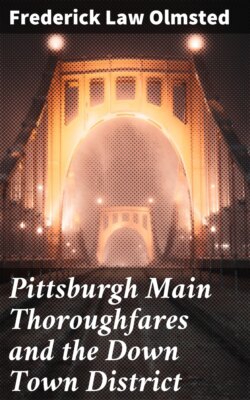Читать книгу Pittsburgh Main Thoroughfares and the Down Town District - Frederick Law Olmsted - Страница 8
На сайте Литреса книга снята с продажи.
Eastward Arteries and Their Improvement
ОглавлениеTable of Contents
There are only three places where such arteries could ever have been laid out, even if the wisest foresight had been exercised in the early planning of the city when all was free and open. These three places are around the north edge of the hills along the Allegheny, around the south edge of the hills along the Monongahela, and through the gap in the hills followed by Fifth Avenue and Forbes Street.
The northerly route is followed by Penn and Liberty Avenues, by the Pennsylvania Railroad, and by Grant Boulevard clinging to the hillside above the railroad. The space between Penn Avenue and the river is largely occupied by railroads and by business dependent upon the railroads, and there seems to be no possibility of opening any new line for relief, except in so far as a subway might reduce the number of people inconvenienced by delays on the surface. On account of its gradients and of the districts toward which it leads at both ends, the usefulness of Grant Boulevard seems likely to remain confined to light passenger traffic, chiefly automobiles. In any case all the teaming and surface traffic of a very large region must be carried through the throat on the lower level. It is important also to note that the only street which passes through the down town district with more than village dimensions—eighty-foot Liberty Avenue—leads directly to this throat and then chokes down to a fifty-foot street.
It may safely be said that increased capacity for east and west general traffic north of the hills can be secured only by a radical widening of Liberty Avenue or Penn Avenue. Upon the whole the latter seems the more advantageous route. On the score of cost there seems to be but little choice; on the score of value in the result Penn Avenue is the better. To have one side of such an important avenue flanked by a railroad to the exclusion of general business frontage would make it less agreeable as a thoroughfare and less productive as a real estate proposition. On the other hand if Penn Avenue is widened the narrow portion of Liberty, above Eleventh Street and next the railroad, will be important almost solely for local purposes; warehouses or factories could be erected extending through from the principal, or Penn Avenue, frontage to Liberty Avenue, and could be provided with sidings from the railroad passing over Liberty.
Further details as to this suggested widening of Penn Avenue and its connections eastward are given, along with other highway improvements, in Part II of this report. But considering here only its relation to the down town district, this widening will undoubtedly throw increased emphasis upon Penn and Liberty Avenues as traffic lines within this district; and it is obvious that a good cross-connection should be provided so that eastbound traffic coming from Liberty Avenue and from Grant Street, as well as from Penn Avenue, can freely reach the widened portion of the latter. A traffic square at the angle in front of the Union Station, where the broad part of Liberty Avenue ends and the narrow part begins, would furnish the desired connection. Fortunately such a square can now be formed with the destruction of but few buildings and those of relatively little cost.[2]
Second Avenue between Try Street and the Tenth Street Bridge
The street along the Monongahela—Second Avenue—although it might have been made of great importance and value by proper planning at the start, cannot at the present time be greatly widened without the most serious difficulties. For much of its length it is pinched between railroads and industrial plants. It does not lead eastward into any district comparable in population or importance with those tapped by Penn and Liberty Avenues, and its connection westward through the Point District is narrow, difficult to widen, and relatively unimportant. For these reasons Second Avenue, although it must be recognized as a main thoroughfare and should be improved as much as practicable, especially as far east as the Tenth Street bridge, is not of such first-class importance as to demand radical enlargement in spite of all obstacles.
The only remaining natural outlet to the east is that occupied by Fifth Avenue and Forbes Street and the block between them. Neither street is wide enough for the traffic it will be called upon to bear, but the widening of Fifth Avenue would be so costly as to be almost out of the question. For many reasons, discussed in detail in Part II, the widening of Forbes Street into an ample main thoroughfare seems to be the best solution of the problem here presented.
The importance of this route and of its future traffic burden will be better realized when it is understood that at Soho a direct extension can be made, on easy gradients, from the widened Forbes Street to Fifth Avenue, the street which can more easily be widened beyond that point; and further, that, a little to the east, a new and greatly needed street might branch off to the right from Forbes Street where the latter turns inland. This new street would continue along the side hill above the river, and would provide the only possible convenient outlet from the down town district to all the upland regions south and southwest of Squirrel Hill. Thus the western portion of Forbes Street, when widened, would carry the great bulk of all future street traffic between the down town district and the whole district from East Liberty to the Monongahela River as well as all the country east and southeast of that triangle.
